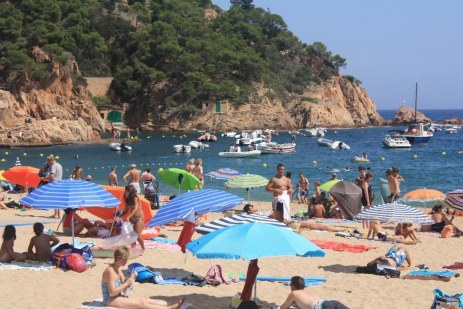Swimming in the deep blue sea
Beside its natural inhabitants, the fishes, the sea receives a multiplicity of other guests during the summer months: swimmers, divers, leisure boats from rowboats and dinghies to yachts and fishing boats for professionals and amateurs of all sizes… Sometimes the groups come together and sometimes this does not occur harmlessly.

Experience tells us that most of these untoward incidents could have been avoided. Each involved party has certain rights, but also has obligations. Very precise laws regulate living together near and on the sea, and just as on land: ignorance is not an excuse to avoid punishment. The maritime rules are very complex; their depth and breadth resembles the civil law, and thus we can not quote all regulations, but CapCreus will try to summarize the few that are particularly importanct to our community.
The first principle is that the right of the weaker one is to be protected. Example: If a motorboat and a swimmer meet, then the boat has to evade the swimmer, since the weaker, the swimmer cannot do much to avoid the boat. If a motorboat and a sailing boat meet, then likewise the motorboat has “to give way,” since the sailing boat is less manoeuvrable.
Now to the details, and here we will begin with professional fishing boats. Registered fish trawlers may begin their work only at a minimum depth of 50 meters. This sounds vague, however, it is very precise. The sea is measured in every detail; and this is registered in sea charts or in electronic databases. The maritime authorities know at each point of the sea whether a fishing boat is within the legal zone. The small fishing boats must keep a distance of 3 nautical miles from the beach, before they may take up their work. A nautical mile corresponds to1852 meters. The same distance also applies to the amateur who is fishing from a boat. No matter, with which style one is fishing by boat, one must respect the THREE-MILE ZONE. Anyone who fishes from a boat while near the shore, even a single line and a piece of bread, is breaking the law. While casual fishing is often tolerated, you are at risk. Fishing with nets or staggered arrays in the proximity of swimmers and divers, of course is both illegal and also very dangerous. But, be aware that even though it may be an illegal act, a citizen does not have the right to remove or harm nets or fishing gear, since they remain private property.
In all cases, amateur fishers must respect a distance of 300 meters from professional fishing boats.
The amateur fisher needs a fishing license. To get a fishing licence is easy, and can be had for a small fee at the “Confraria dels Pescadors”. Three kinds of licenses are available: fishing licence type number 1 permits the leisure fishery from the surface of the sea. Fishing licence #2 permits divers to hunt for fish. An owner of license type #3 may fish both under water and from the surface. Licence #3 applies also to accompanying persons, which is not the case with license Numbers 1 and 2.
Divers: In principle each diver, who is in the sea beyond the shoreline bathing zone must indicate his presence with a diving buoy: the buoy will be orange colour for divers without air bottles, and red with white strip for divers with breathing apparatus. The diver may move in an area that does not exceed 15 meters around his buoy (determined by the length of the line). Boats may approach no closer than 25 meters from such a buoy. If there is a service boat that is serving a number of divers — the boat must be marked with the alpha flag (white – blue) — other boats may not approach closer than 100 meters.
It is forbidden for a diver to hunt with an air tank and a harpoon. It is also forbidden for a free diver (diver with snorkel) to enter the water from a boat. A snorkeler, determined to hunt for fish, must enter the water at the water’s edge.
Divers with air tanks must end their hunt by sunset. Hunting after sunset places the diver at risk of having his or her equipment confiscated.
To navigate a boat with a motor require a valid boat driving licence.
A boat may approach a beach, while under power, but at speeds less than 3 knots. And, the approach must be within the entry corridor characterized by a green and red buoy. The same maximum speed applies for starting and leaving from port.
And, what about people bathing in the water? The municipalities are obligated to mark public beaches with yellow buoys to outline the secure area for swimming. Within these zones the bathers enjoy almost unlimited liberty, but there are always some restrictions; for example boats may intrude in the case of an emergency. Always be alert to others.
Our article may be boring and may seem too restrictive, with so many “must” and “may” and “may not,” but we to think that it is better to be safe than to be sorry. We wish everyone a beautiful vacation at the beach, on the sea, in a boat, while fishing . . . or in the disco.

